Unapologetically Japanese: The Rise of Takashi Murakami, a Global Art Icon
He became a world-class artist — just as he had planned
Have you ever wondered how modern artists can achieve success? As you might imagine, it’s a cutthroat battle. However, a Japanese artist believed it was possible to win it strategically. His name is Takashi Murakami (村上隆, 1962 — ).
As he wrote in his book ‘芸術起業論 (Art Business Theory)’, he ‘went through a period of having no money, where I would get expired bento from convenience stores until I was 36 years old’. He admits he did not have any outstanding talent, either. Still, he never lost hope. The young artist researched the art industry, devised effective tactics, and put them into practice.
The result?
In 2012, the American lifestyle magazine Complex published a list of the 15 richest living artists based on its own research. Damien Hirst came in first place, while Takashi Murakami came in sixth.
Yes, he succeeded precisely as he had planned.
In this article, I will share some of his effective strategies and some of his work. Even if you are not an artist, you will get hints on how to approach your career.
It’s rather hard for Japanese artists to achieve global success

First, could you name about ten modern world-famous artists that come to mind?
Thank you.
Many would probably name Van Gogh, Picasso, Monet, Warhol, Hirst, Basquiat, Haring, Hockney, etc. Some people might also think of Ai Weiwei and Yayoi Kusama, but many of the masters that people think of first are Western artists.
The main reason for this is related to the fact that the centre of the art world was Paris before the war, and then moved to New York and London. Do I need to explain how the world revolves around the West and how wealth is unevenly distributed?
With this in mind, to succeed as a world-class artist today, you first need to gain attention in either the US or the UK. Then, you can meet influential art dealers and have your work purchased by wealthy people. This will make it much easier for you to achieve global success later. That’s why you can always see the works of exciting up-and-coming artists from around the world in New York and London.
However, Westerners naturally tend to support Western artists. Chinese and Japanese art has already been given a certain amount of respect in Europe over the centuries, as they saw trends such as Chinoiserie and Japonisme. Still, to be highly regarded today, the work must be unique and easily understood from a Western perspective.
What Yayoi Kusama, Yoko Ono, and Takashi Murakami have in common

‘Hey, but as you wrote in your previous articles, Yayoi Kusama and Yoko Ono are both so successful worldwide,’ you might say. Yes, that’s true. But have you ever thought about what they have in common?
They had been active as artists in New York since they were young. In other words, they had plenty of opportunities to meet other artists in America, learn about trends, and build up a network of contacts they could use in collaborations and business. If they had kept living in Japan, their global success would at least not have been as smooth.
Takashi Murakami also decided to follow in the footsteps of these illustrious pioneers. He studied in New York on a scholarship from the Rockefeller Foundation. He actively promoted himself there, laying the foundation for his current global success.
What Americans like about Japan: Kawaii and Otaku cultures
However, as mentioned earlier, Takashi Murakami needed to convince Americans of his unique art style.
The strategy he chose at that time was to unashamedly promote his Japaneseness because Western artists cannot do that. In Japanese, ‘fight on equal terms’ is expressed as ‘fight on the same sumo ring’. It is clearly more desirable for Japanese artists to create a sumo ring and fight there rather than facing top boxers in an unfamiliar ring.
At the same time, he had to explain the work’s appeal in a way that Americans could understand. Even if he had talked about a sense of beauty that was almost exclusively understood by the Japanese, all he would get in return would have been puzzled looks and yawns.
He wondered what kind of Japanese culture no other country in the world could compete with. Fortunately, it existed: kawaii and otaku cultures! In the 1990s, these two had already gained some recognition in America.
Murakami carefully developed his concept, ‘Superflat’ (to be discussed later), based on these two main cultures. He then presented it at various gatherings. As he had predicted, American art dealers and wealthy art fans were excited by it and supported him.
Murakami once dreamed of being an animator and a Japanese-style painter
Indeed, he had the potential to put this concept into practice.
Firstly, he is a huge anime fan. He admired Hayao Miyazaki and wanted to become an animator when he graduated from high school, but he couldn’t make it.
So, he studied traditional Japanese painting, which he was also interested in, and entered the Tokyo University of the Arts to study Japanese painting. However, after missing out on first place in the master’s course production, he realised the limits of his talent and gave up on becoming a Japanese painter.
This means he could not realise either Plan A as an animator or Plan B as a Japanese-style painter.
Nevertheless, Murakami had a Plan C: to make his debut as a contemporary artist. In 1991, he held his first solo exhibition, ‘Takashi, Tamiya’. After that, he made full use of his experience and connections in America and quickly rose to stardom in the world of art. In 2008, Time magazine selected Murakami as one of the ‘100 Most Influential People in the World’.
He knows he is not a genius like Hayao Miyazaki or Katsushika Hokusai. He said, ‘I can’t be a genius like Matisse, but I understand the views of artists like Picasso and Warhol’.
He became a successful contemporary artist because he critically recognised his limitations and considered how to make the most of his limited talent.
Superflat: An inclusive world where all boundaries disappear
To become a top-class artist, you need to create a unique style. It is also effective to ask yourself, ‘What is art?’. Marcel Duchamp’s ‘Fountain’ and Andy Warhol’s ‘Campbell’s Soup Cans’ are good examples.
Takashi Murakami is not afraid of controversy or harsh criticism. In fact, he seems to think that it is a rite of passage to even greater success. Needless to say, there are very few artists with such toughness. Most people want their work to be praised.
Anyway, he started the art movement called ‘Superflat’, which is easy to understand, unique, Japanese, and powerful. ‘Superflat’ has various meanings, but I would like to focus on three of them. Also, let’s look at how these elements are expressed through some of the works from the ‘Japanese Art History à la Takashi Murakami’ exhibition held in London from December 2024 to March 2025.
Firstly, it is visually flat. Whether it is traditional Japanese painting, ukiyo-e or modern manga, Japanese art does not have the same sense of depth as Western art. Following this, Murakami’s works also emphasise a flat worldview.
‘Kyoto Korin Mononoke Flower’ is based on the works of Ogata Kōrin (尾形光琳, 1658–1716), the great master of the Rinpa school. You can see that it looks two-dimensional. The tiny faces drawn in the flowers are, of course, Murakami’s original idea.
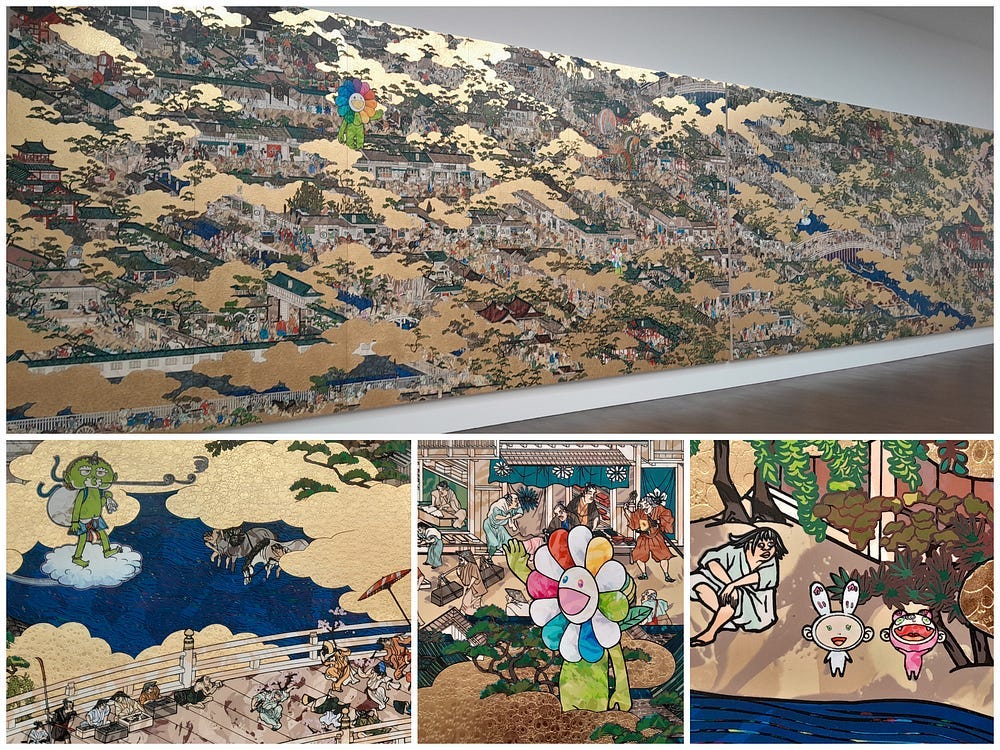
Secondly, he makes no distinction between fine art and pop art. Murakami combines traditional, elegant Japanese paintings with subculture, as represented by anime and manga. This is more shocking for the Japanese, because it is like serving fish and chips on a Wedgwood plate.
The term ‘Rakuchū Rakugai-zu (洛中洛外図)’ refers to paintings that depict the scenery of Kyoto as seen from above. They were painted by various artists from the end of the Muromachi period to the Edo period.
Among these, the folding screen paintings by Iwasa Matabei (岩佐又兵衛, 1578–1650), a master of the Edo period, are particularly famous, and the above work is based on them. Although most people wear kimonos from the Edo period, you can find some cute characters that are familiar from the other works of Takashi Murakami.
Also, look out for the countless skulls embossed on the gold leaf. These represent the people who lived and died in Kyoto, a city with a long history. The nobles, samurai, townspeople, and entertainers depicted here are all now dead. The message is that we who look at this will one day join them as equals. You can also feel the Superflat concept here.
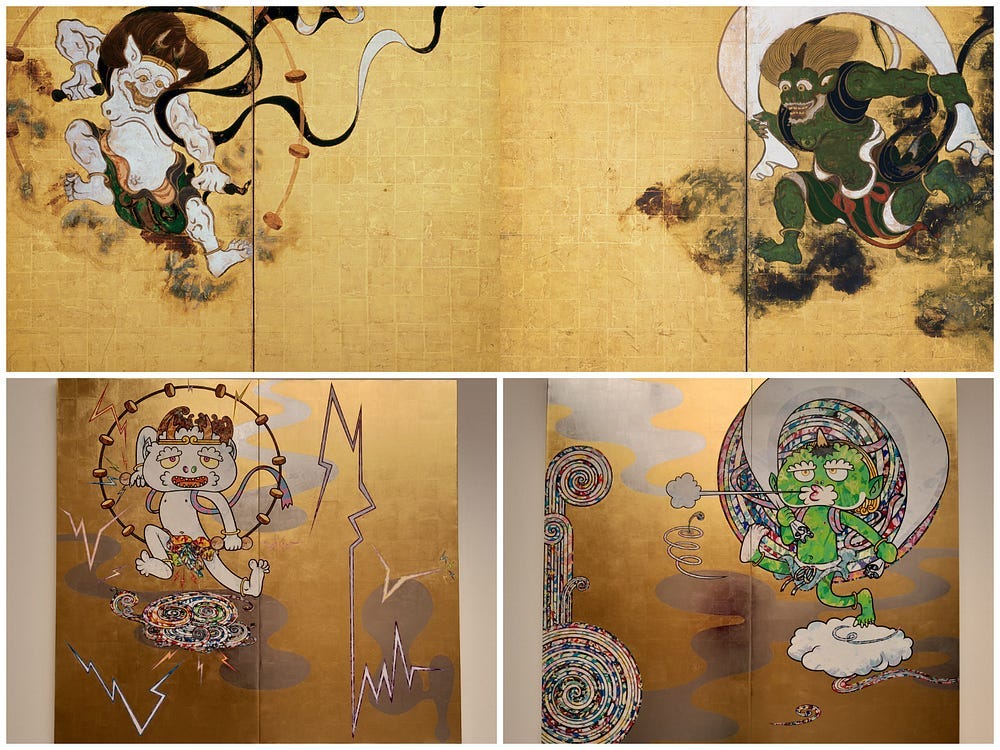
Finally, his art also reflects Japanese society’s lack of class structure. In 1968, Japan’s GDP reached second place in the world, and as people’s lives became generally more affluent, the phrase ‘一億総中流 (all 100 million people in the middle class)’ came into common use. In a 2013 survey, over 90% of the population felt they were ‘middle class’. Such a society is rare when viewed globally.
The National Treasure folding screen painting ‘The Wind and Thunder Gods’ by Tawaraya Sotatsu (俵屋宗達, 1570–1643), a master of the Rinpa school, was also given a humorous manga-style appearance by Murakami. Although it does not depict human social classes, it is also characteristic of him to make something with such dignity into a familiar form. In this sense, too, his work is Superflat.
Many Europeans and Japanese are still unconvinced
As mentioned earlier, Takashi Murakami has made every effort to gain American fans, and it has paid off, making him one of the most famous artists in the world.
However, many enthusiastic art fans and critics in Europe and Japan are still unconvinced.
In particular, the reception in Japan has been harsh. Some critics have said that his work is ‘just a mishmash of various Japanese art forms’ and ‘doesn’t contain enough depth to be called otaku’. As Japanese art fans, we have constantly been exposed to the best Japanese paintings and anime, so it is difficult to feel a sense of freshness in Murakami’s work.
Although there are still some sceptical critics in Europe, there are more and more opportunities to see his art in this region. One notable example is his collaboration with Louis Vuitton.
American fashion designers made his collaboration with Louis Vuitton a reality
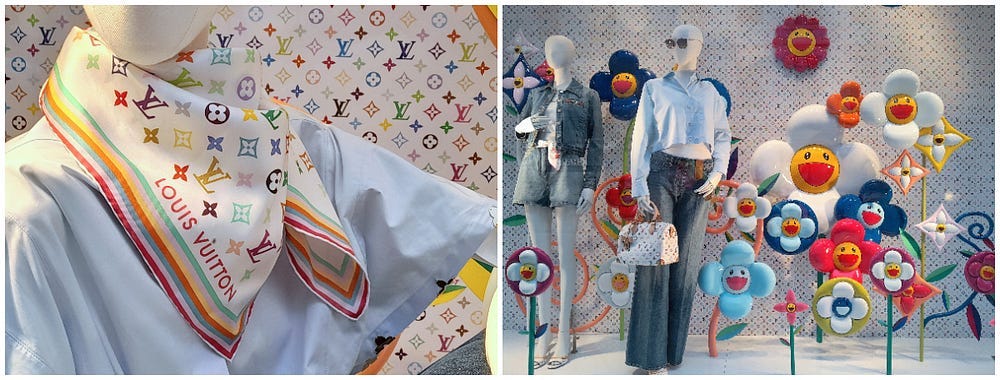
In 2003, this chic French brand released a collection featuring Takashi Murakami’s colourful pop designs, which was a huge sensation among art and fashion fans. Nowadays, such collaborations are not uncommon, but at the time, they were. Also, through this, some people in the world realised that the ‘kawaii culture’ was not just a passing fad.
Then, in January 2025, the original collection was re-created and updated, and the re-edition ‘LOUIS VUITTON × MURAKAMI’ was released. The ‘Monogram Multicolore’ was revived, and it decorated the windows of Louis Vuitton stores worldwide.
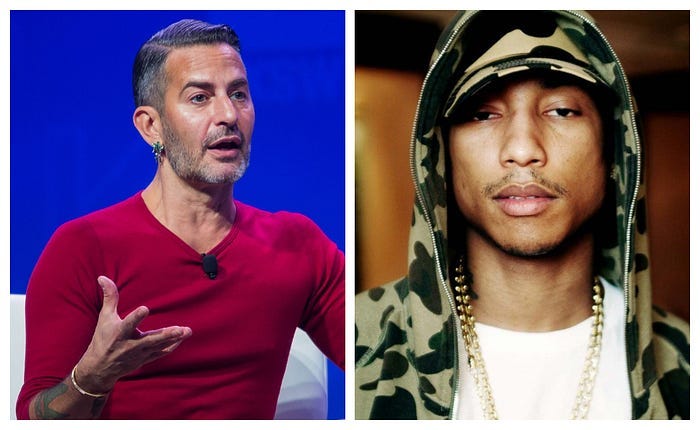
In fact, such success is also linked to the high regard in which he is held by Americans.
Marc Jacobs, an American designer known as a fan of Japanese fashion and art, was the man behind the first collaboration between Takashi Murakami and Louis Vuitton. When Murakami was unsure of his strategy, Jacobs encouraged him to ‘be crazier’. He expressed his deep gratitude to Jacobs’ team, who generously supported him.
The collaboration for 2025 is with Pharrell Williams, an American music producer who has also been appointed as the creative director of Louis Vuitton.
This was probably an unexpected stroke of luck for Takashi Murakami. By gaining more American fans, he could spread his name and work to Europe and beyond.
The wealthy art collector, the Princess of Qatar, is also backing him
The influential people who highly regard Takashi Murakami are not just Americans. The first person to be mentioned is Princess Sheikha Al Mayassa of Qatar. In 2013, she was ranked number one in the world in the ‘Power 100’ list of influential people in the art world, published by the British art magazine ‘Art Review’.
Qatar aims to become a cultural nation specialising in contemporary art. Under the auspices of the Qatar Museums Authority, which is run by this princess, Takashi Murakami’s solo exhibition ‘Murakami-Ego’ was held in Doha, Qatar, in 2012.
The Qatari government also supported Takashi Murakami’s controversial 2010 exhibition at the Palace of Versailles.
He now has fans in many parts of the world.
Next stage, next strategy

Takashi Murakami is also known for his readiness to invest in new projects. In his grand and meticulous strategy, his current status as a world-class artist may only be the beginning.
After making the US and Qatar swoon, will he set his sights on Europe or his home country of Japan next? Either way, I’m thrilled to see how things develop.
A week ago, it was announced that Murakami’s art production company would purchase a plot of land in Kyoto City’s Minami Ward for approximately 300 million yen. It is planning to build an art studio on the site. Of the 50 staff members at the new studio, around half will be recruited from local art universities and colleges.
Young, talented Japanese artists will meet Takashi Murakami and undoubtedly learn a lot from him as a strategist and artist. This valuable opportunity may lead to the birth of the next star artist.




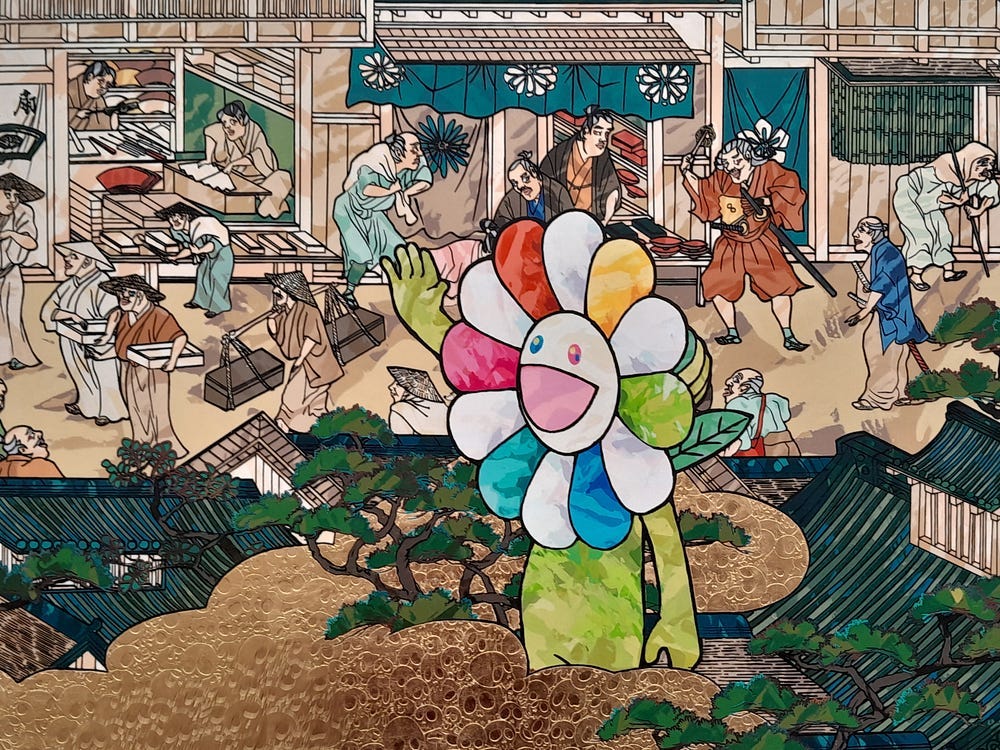

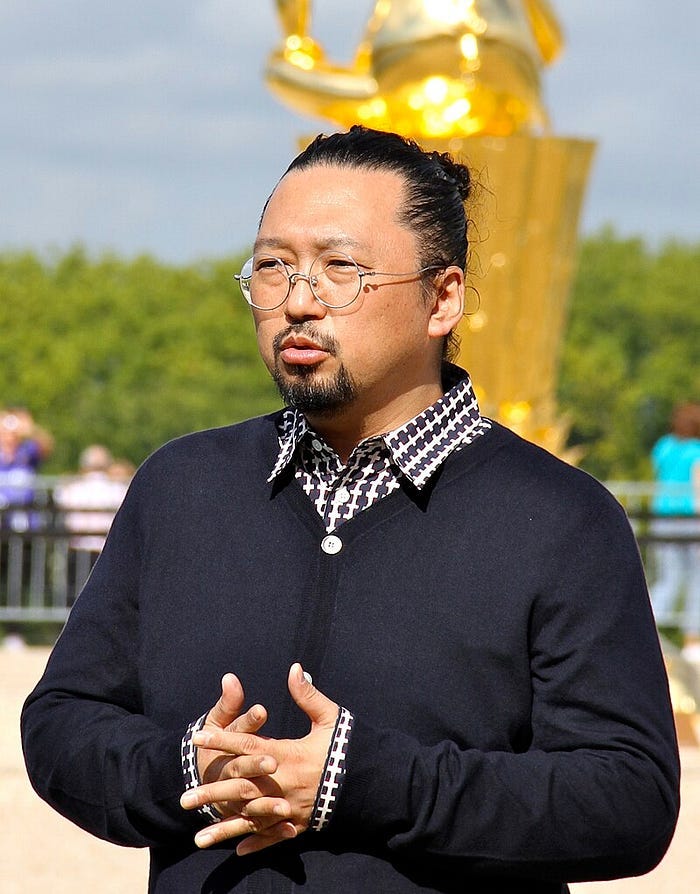
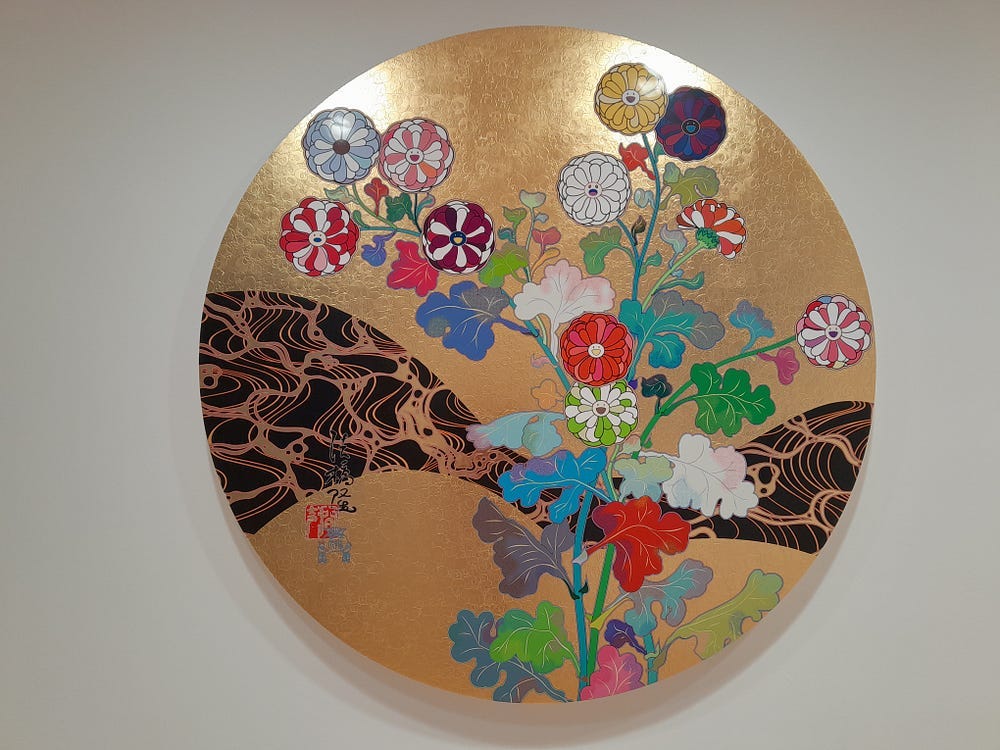
Really interesting, thank you for sharing.